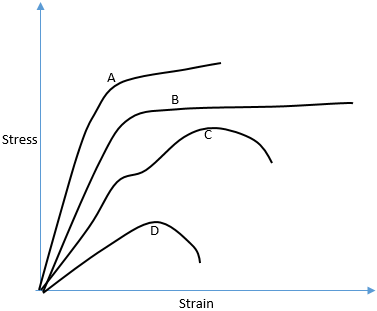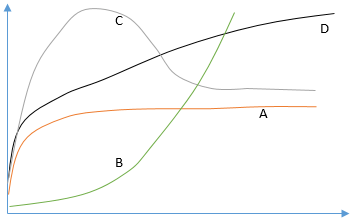This set of Mechanical Metallurgy Multiple Choice Questions & Answers (MCQs) focuses on “Metal Working Fundamentals – Residual Stress”.
1. In which of the following process, the deformation and recovery take place together?
a) Cold working
b) Warm working
c) Hot-working
d) Every process it does occur
View Answer
Explanation: In the hot working, the temperature is sufficiently high so that the deformation will take place but along with that recovery of the structure takes place at the same time.
2. Which of the following shows the correct hot working behavior of the metal?

a) A
b) B
c) C
d) D
View Answer
Explanation: In hot working, the temperature is sufficiently high so that the strain hardening can be avoided; also, the much higher deformation is possible without causing the fracture of the metal.
3. The dimension tolerance allowances are much more significant for hot working process compared to cold working process.
a) True
b) False
View Answer
Explanation: In hot working, at high temperatures the surface oxidation is predominate phenomena; this oxide layer needs to be removed. Hence, tolerance should be provided to compensate for this extra material.
4. In a hot worked piece of metal, the grain size in the interior of the metal is __________ the outer surface.
a) larger than
b) smaller than
c) equal to
d) depend on temperature
View Answer
Explanation: The interior of the metal remains at a higher temperature for longer time compared to the exterior of the metal. So the grain growth occurs in the center, and grain size becomes large.
5. Hot-working is generally carried out in multiple steps whereas the cold working is carried out in single step.
a) True
b) False
View Answer
Explanation: The cold working is carried at the temperature where the ductility of the metal is low, so to avoid the breaking of sample it is carried out in multiple steps, whereas the hot working can be done in single or minimum number of levels.
6. In which of the following metalworking process, the control on grain size is maximum?
a) Cold working
b) Hot-working
c) Cold-annealed-cold working
d) Cold-annealed-hot working
View Answer
Explanation: In the hot working and cold working desired nature of grain size flow can be determined, but exact control on it is difficult; but in cold-annealed-cold working, the material is first deformed then annealed to the level where the desired grain size is obtained, then again cold worked to achieve the strength.
7. In which of the following metal working process, the temperature is kept highest?
a) Subcritical working
b) Cold working
c) Warm working
d) Hot-working
View Answer
Explanation: The warm working is carried out at the temperature above room temperature and below the recrystallization temperature, so it takes advantage of both the cold working and hot working. So, hot working has the highest operating temperature.
8. As the strain rate of deformation increases, the temperature of the workpiece due to internal heating ____________
a) increases
b) decreases
c) remains constant
d) depends on the coefficient of friction
View Answer
Explanation: As the strain rate or rate of deformation increases, the heating due to internal friction between the workpiece and tool cause more heating of the workpiece.
9. The stress-strain curve for hot worked metal which has undergone dynamic recovery with increasing strain is _______

a) A
b) B
c) C
d) D
View Answer
Explanation: In dynamic recovery, the strain hardening after certain point becomes zero and material can be extended for prolonged period without causing increase in required stress.
10. The stress-strain curve for hot worked metal which has undergone dynamic recrystallization is _______

a) A
b) B
c) C
d) D
View Answer
Explanation: The dynamic recrystallization is always followed by dynamic recovery. So initially, the required stress increases, but after dynamic recrystallization the stress value reduces drastically.
11. The dynamic recrystallization occurs at high dislocation density whereas the dynamic recovery occurs at lower dislocation density.
a) True
b) False
View Answer
Explanation: The recrystallization always occurs after dynamic recovery, so in recovery the annihilation of dislocation takes place, but if dislocation forms a cell structure and stacking fault energy is low, it tends to undergo dynamic recrystallization.
12. The plastic strain ratio is defined as the _______________ (where Wi, Wf is initial and final width of work piece, Li, Lf is initial and final length of work piece).
a) ln(Wi/Wf)
b) ln(Wi/Wf)/ln(Li/Lf)
c) ln(Wi/Wf)/ln(LfWf/LiLf)
d) ln[(Wi/Wf)/(LfWf/LiLf)]
View Answer
Explanation: The plastic strain ratio is defined as the change in the width over the change in cross sectional area of the sheet.
-> ln(Wi/Wf)/ln(LfWf/LiLf).
13. If the width is decreased by 20% and length is elongated by 30%. Find the plastic strain ratio of the workpiece?
a) 4.25
b) 5.71
c) 2.32
d) 1.025
View Answer
Explanation: The plastic strain ratio is defined as:
-> ln(Wi/Wf)/ln(LfWf/LiWi)
-> ln(w/0.8w)/ln(1.3L*0.8W/L*W)
-> ln(1/0.8)/ln(1.3*0.8)
-> 0.223/0.039
-> 5.71.
14. In deep drawing to obtain the best result, which of the following property should be minimum?
a) Ductility
b) Plasticity
c) Planer anisotropy
d) Plastic anisotropy
View Answer
Explanation: The planer anisotropy is the tendency of the material to remains in a particular direction. So if the material is deeply drawn, and material has high anisotropy, it will crack before reaching to the desired shape.
15. In which of the following process, the container wall friction is absent?
a) Direct extrusion
b) Impact extrusion
c) Hydrostatic extrusion
d) Tube drawing
View Answer
Explanation: There is a fluid between the billet and wall. So, technically there is contact between the billet and the container wall, so friction is absent and the maximum productivity is obtained.
16. The LPG cylinder is manufactured by which of the following metal working process?
a) Casting
b) Rolling
c) Spinning
d) Forging
View Answer
Explanation: The LPG cylinder is manufactured by forging process because the sheet thickness used to make cylinder is very thick, so forging is only economical method which provides strength and desired shape.
17. The residual stress in the material after metalworking can be detected by which of the following method?
a) Hardness
b) Metallographic
c) Scanning electron microscopy
d) X-ray analysis
View Answer
Explanation: The residual stress in the material is determined by X-ray analysis. The concept is that the lattice spacing of the material changes with change in residual stress of the material, so the corresponding diffraction pattern changes.
18. The gutter flash is associated with which of following metalworking process?
a) Rolling
b) Forging
c) Extrusion
d) Swaging
View Answer
Explanation: The flash is the term used for extra material that is flushed out of the cavity of close die. Hence, it assures the complete filling of the pit and reduces the required stress.
Sanfoundry Global Education & Learning Series – Mechanical Metallurgy.
To practice all areas of Mechanical Metallurgy, here is complete set of 1000+ Multiple Choice Questions and Answers.
If you find a mistake in question / option / answer, kindly take a screenshot and email to [email protected]
- Check Mechanical Metallurgy Books
- Apply for Metallurgical Engineering Internship
- Practice Metallurgical Engineering MCQs
- Check Metallurgical Engineering Books
